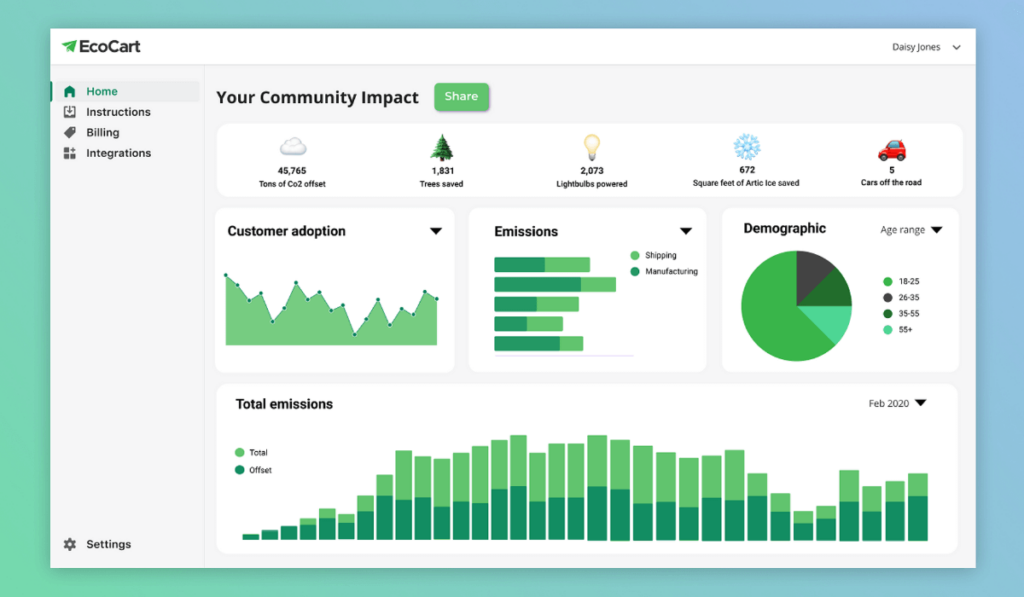If your company wants to earn green business certifications and prove itself to be eco-friendly, it needs proof. Carbon accounting can help you along your journey towards carbon neutrality and back up your claims once you get there.
Carbon accounting takes a lot of time and data to do properly. Thorough and accurate carbon accounting must look deeply into your operations, the life cycle of your products, and your supply chains to gain a full picture of your carbon dioxide footprint. It can be overwhelming, but it’s an essential step toward reaching carbon goals. Here’s our guide.
What Is Carbon Accounting?
Carbon accounting—sometimes referred to as greenhouse gas accounting or GHG accounting—is a calculation of an organization’s greenhouse gas emissions. Using a trusted framework, it quantifies a company’s carbon emissions impact, enabling it to assess its current footprint, measure its progress, and strategize ways to reduce GHG emissions. The main goal of carbon accounting is to let you and any stakeholders know exactly where you stand when it comes to carbon dioxide emissions.
Why Is Carbon Accounting Important For Ecommerce Businesses?
Effective carbon accounting will paint an accurate and science-backed picture of a company’s total greenhouse gas emissions so that it can make effective changes. This is important for several reasons:
- Build trust with stakeholders, including customers, investors, and employees.
- Provide proof that your company is adhering to environmental regulations, laws, and reporting requirements.
- Accurately portray your current standing so that you can build an effective environmental strategy and create sustainability KPIs.
- Help your company procure relevant green business certifications, such as B Corp, LEED, the Green Seal, and more.

Common Carbon Accounting Frameworks
Because there’s no global carbon accounting standard, carbon accounting entities use one of many established frameworks to assess and quantify your GHG emissions. Carbon accounting frameworks can be industry-specific or general. Here are some common frameworks that entities may follow.
- The Greenhouse Gas Protocol: The GHG Protocol is the world’s most used carbon accounting framework. A majority of Fortune 500 companies have used the Greenhouse Gas Protocol either directly or indirectly, and numerous cities and governments around the world have, too.
- Intergovernmental Panel on Climate Change (IPCC): The IPCC is the UN’s body in charge of scientifically assessing the state of climate change. It provides a thorough, transparent, and science-backed methodology for carbon accounting.
- The Carbon Disclosure Project (CDP): The CDP is a trusted impact disclosure non-profit that helps companies, cities, and governments measure, track, and disclose their carbon footprint. The CDP provides an environmental score as well as risks and opportunities to improve.
- Global Reporting Initiatives (GRI): The GRI provides a range of standards that cover biodiversity, carbon emissions, equality, and more.
What Is Required For Carbon Accounting?
Carbon accounting is done in two steps: your company’s carbon data is collected, and that data is then analyzed to determine the scope of its footprint. Solid greenhouse gas accounting software will be as detailed as possible to ensure accurate and transparent results.
Remember, when you’re applying for a green business certification or building trust among stakeholders, honesty and fastidiousness are key. As you volunteer your carbon data, make sure that it paints an accurate picture of your current impact.
Let’s take a closer look at the stages of carbon accounting.
1. Emissions data
During the first stage of the carbon accounting process, the data surrounding your company’s greenhouse gas emissions will be collected. This will include both direct and indirect carbon emissions, otherwise known as Scope 1, Scope 2, and Scope 3 emissions.
- Scope 1 emissions = the direct emissions that your company produces (e.g. energy use from company facilities or emissions from company vehicles).
- Scope 2 emissions = indirect emissions from purchased electricity, heat, etc.
- Scope 3 emissions = indirect emissions from employee travel, carbon emissions along your supply chains, product transportation, etc.
This business data includes figures like your spend data (how much money your company spends on certain products or services) and activity data (e.g. how much fuel your company uses per month). Emissions factors will also be analyzed to determine your carbon dioxide emissions, which consider greenhouse gasses associated with each unit of business data.
Want to know where your business stands? Get your sustainability scorecard with our quiz:
2. Carbon accounting methods
Once the appropriate data has been collected, your greenhouse gas emissions will be calculated. There are some different ways that this may be done, depending on the framework used by the carbon accounting entity.
- The spend-based method analyzes the amount of money spent on a product or service and multiplies that number by the estimated emissions factor. While this data is easy to analyze, it requires some guessing, so it’s not as accurate as it could be.
- The supplier-specific method analyzes your products’ cradle-to-grave greenhouse gas data from suppliers of goods or services. This method is highly beneficial as it analyzes Scope 3 emissions—which constitute as much as 90% of a company’s emissions—and the data gathered is accurate and specific. However, it’s often difficult to gather this type of data for analysis as it requires cooperation from your supply chain. Learn how to conduct a supply chain audit.
- The physical-unit method analyzes how much electricity is used, how much gasoline is consumed, and so on. While this is one of the most accurate ways to show energy consumption and measure greenhouse gasses, it requires a lot of effort from the company and its suppliers to gather this data, and it doesn’t always accurately paint the picture of product emissions.
- The hybrid method combines spend-based and activity-based methods. It collects as much activity-based data as it can from both suppliers and the company itself, then it fills in the gaps with spending data. This is the most comprehensive and accurate approach, and it’s the one recommended by the GHG Protocol, which is why most companies use this methodology.
As your company looks for carbon accounting entities and begins gathering the appropriate data, it’s important to keep these carbon accounting methodologies in mind. This will help you organize your data properly and get your supply chains on board before the accounting process even begins.
Your emissions estimates will likely be broken into Scope 1, Scope 2, and Scope 3 emissions. Keep in mind that it’s common for the majority of a company’s emissions to be Scope 3. This means that your strategies for reducing emissions will need to include your supply chains.
Understand where your emissions are coming from and how they are changing in real-time with EcoCart’s Sustainability Insights Dashboard.

3. Sustainable solutions
Once you’ve received the results of your carbon accounting, the journey isn’t over. Carbon accounting scores can be used in several ways, from building a more robust sustainability program to laying the foundation for sustainability initiatives that will help your company reach net zero emissions.
Depending on your carbon accounting results, you may need to conduct a deep dive into operations and make some major changes.
Here are some simple ways that you can start improving your carbon output.
- Offer carbon neutral shipping to your customers at checkout to offset carbon emissions associated with delivery.
- Conduct a life cycle analysis to see in which areas you can improve your footprint.
- Begin transitioning to renewable energy sources for your facilities.
- Invest in a green web host for your ecommerce site.
- Meet with your suppliers to strategize ways that they can reduce their carbon footprint and how you might support them.
- Switch to sustainable, non-plastic packaging.
Learn more about taking responsibility for your Scope 3 emissions by decarbonizing your supply chain.
Why Should My Business Use Carbon Accounting?
Carbon accounting allows companies to see the areas that can use the most improvement, earn green business certifications, build trust with stakeholders, and comply with environmental legislation and ESG reporting laws. Investing in carbon accounting offers plenty of benefits for your ecommerce business now and in the future. Here are some big reasons why companies large and humble should use carbon accounting.
- Reduce your carbon footprint. The only way that your company can effectively reduce its carbon footprint is by gaining a science-backed perspective of where your carbon footprint currently stands. Only then can you strategize ways to reduce it.
- Earn green business certifications. To gain a green certification, your company will need to go through a sustainability audit. If you invest in carbon accounting before applying for a certification, you’ll see exactly where you stand, and either enter the application process confident or work on the areas that need improvement.
- Meet sustainability reporting requirements. In countries all over the world, including the U.S., sustainability reporting is required. Carbon accounting can help you achieve these requirements.
- Earn competitive advantages. Investors, customers, and employees want to support companies that align with their values. A good carbon accounting score will show stakeholders that you’re serious about your carbon goals.
- Avoid greenwashing accusations. Today’s consumers are savvy, which means that even well-meaning companies can fall victim to greenwashing accusations. The last thing that you want is for your sustainability story to turn sour because your well-intentioned strategy doesn’t have the impact that you anticipated. Carbon accounting will provide proof of your efforts from a third party, or it will reveal areas where you can do better so that you can produce a comprehensive sustainability plan.
- Become more efficient. Often, a company’s carbon footprint is the result of inefficient practices. For example, long shipping distances from poorly placed warehouses can increase shipping costs and times and inflate your carbon footprint. As carbon accounting points out areas where you can reduce your GHG emissions, your solutions may also result in efficiency.
Conclusion
Carbon accounting is essential for any business that seeks to be green. It uses expert methodology so that you can gain an accurate view of your carbon footprint and strategize ways to improve it.
As you pursue carbon neutrality, EcoCart’s emissions dashboard can help you see your areas of impact in real time. This allows you to instantly pinpoint problem areas and quickly mitigate them, ensuring that you can receive high carbon accounting scores. Interested in learning more? Reach out for a demo today.



